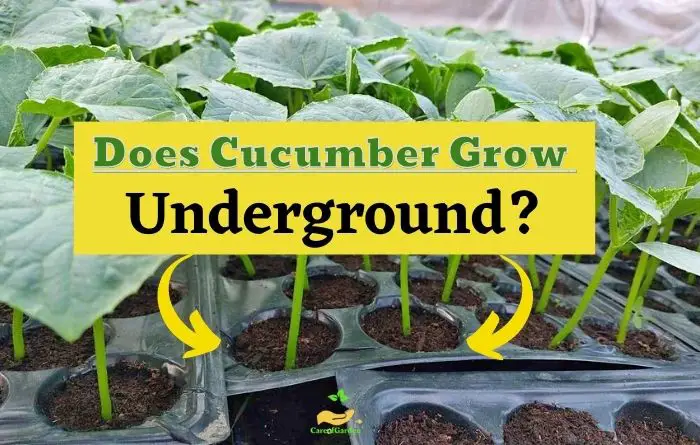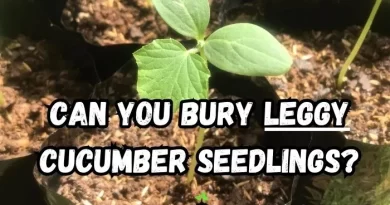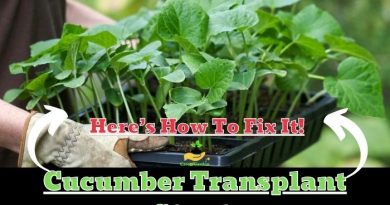Does Cucumber Grow Underground? (Easy Answer Here)
Home gardeners often ask, “Does cucumber grow underground?” it is worth wondering. But, the answer is a clear “No,” as cucumbers are vining plants that do not grow underground. They spread out along the soil surface or climb to the nearby support.
In this article, you will find more scientific reasons and facts for their vining behavior, growth patterns, and how to grow cucumber vines. So, let’s get started.
Does Cucumber Grow Underground?
No, cucumbers are above-ground plants. They are plants that thrive above ground, attached to creeping vines that can grow vertically with the right support. While cucumbers may have a taproot that can grow a depth of up to four feet deep, the majority of their roots spread outward from the plant and remain just below the soil surface.
Scientifically, the plants that grow underground have specialized structures that allow them to thrive in those conditions. These structures include bulbs, root tubers, rhizomes, and tuberous roots. While in cucumbers, there is a fibrous root system composed of shallow branching roots. These roots do not grow deep in the soil but spread horizontally near the soil surface.
Similarly, plants growing underground have an energy storage system that stores energy to survive in unfavorable conditions, and cucumbers have no mechanism. Their roots anchor the plant in the soil, and they absorb water and nutrients from the top layer where they are readily available. The long trailing stem of cucumber plants allows photosynthesis which would otherwise restrict growth if they are grown underground.
Thus, growing cucumbers underground is practically not possible, and you can get plentiful harvests by growing them on the ground or vines.
Reasons Why Cucumber Don’t Grow Underground
Cucumbers don’t grow underground for several reasons:
- Plant Structure: Cucumber plants have a vining growth habit with long trailing stems that climb or spread along the ground. The fruits develop from flowers that appear on these vines, and they grow outward from the stems, making them visible and accessible for harvesting.
- Photosynthesis: Like most plants, cucumbers require sunlight for photosynthesis, the process by which they convert light energy into chemical energy. Photosynthesis primarily occurs in the leaves, which need exposure to sunlight to produce sugars and nutrients for plant growth. Underground growth would restrict the access of leaves to sunlight and hinder the photosynthetic process.
- Pollination: Cucumber plants require pollination to produce fruits. Cucumber flowers produce both male and female flowers, and they rely on bees and other pollinators to transfer pollen from male to female flowers. If cucumbers were to grow underground, it would be challenging for pollinators to reach the flowers and facilitate the pollination process.
- Water drainage: Proper drainage is essential for the health of cucumber plants. Growing cucumbers underground could lead to poor water drainage, increasing the risk of root rot and other water-related diseases. By growing on the surface, excess water can drain away more easily.
- Fruit Development: Cucumber fruits require adequate air circulation and exposure to sunlight for proper development. Growing cucumbers above ground ensures that the fruits receive the necessary light, warmth, and air circulation to mature and ripen properly.
- Harvesting: Growing cucumbers above ground makes it easier to monitor their growth and harvest them at the right time. Cucumber fruits are typically harvested when they are still green and before they become overripe. Above-ground growth allows for convenient observation and timely harvesting.
- Physical constraints: Cucumbers are vining plants that require space for their sprawling growth habit. Growing underground would restrict their ability to spread out and may result in stunted growth.
In summary, cucumbers are not designed to grow underground due to their vining growth habit, reliance on sunlight for photosynthesis, dependence on pollinators for fruit development, and the practicality of monitoring and harvesting the fruits when they are ready.
Comparison of Cucumber Plants with Underground Growing Plants
| Aspect | Cucumbers (Above-Ground Growing Plants) | Underground Growing Plants |
|---|---|---|
| Growth | Vine plants that spread above the ground | Edible parts develop underground |
| Sunlight | Require direct sunlight | Can tolerate shaded environments |
| Oxygen Requirement | Need atmospheric oxygen through roots | Obtain oxygen from soil air pockets |
| Nutrient Absorption | Absorb nutrients from top soil layer | Derive nutrients from surrounding soil |
| Water Drainage | Require well-drained soil | Adapted to retain moisture in the soil |
| Pollination | Require pollinators for fruit development | Not reliant on pollinators |
| Space Requirements | Need space for vine growth | Compact growth habits |
| Harvesting | Fruits picked when ripe | Edible parts unearthed from the soil |
| Pest and Disease Management | Above-ground pests and diseases | Root system and underground organ issues |
| Adaptability | Suited for raised beds, containers, gardens | Cultivated in the ground |
Does Cucumbers Grow Underground from Seeds?
No, cucumbers do not grow underground from seeds. Cucumbers are a type of vine plant, and their growth occurs above the ground. When you plant cucumber seeds, they will germinate and develop into seedlings that grow above the soil surface.
Furthermore, instructions for planting cucumber seeds, such as those provided by Get Busy Gardening, emphasize the need for well-draining soil and ample sunlight, both of which are not typically found underground.
Do Cucumbers Grow on the Vine or Underground?
Cucumbers grow on the vine, either on the ground or vertically on a trellis or fence. Vining cucumber plants can scramble along the ground, or climb up trellises or other structures. Bush-type cucumbers, on the other hand, form a more compact plant and are less likely to require support. Generally, vining cucumbers yield more fruit throughout the growing season, and they can be trained to grow vertically to save space and make harvesting easier.
These fruits grow outward from the stems and are typically visible and accessible for harvesting. While the cucumber plant’s roots are in the soil, the majority of its growth and fruiting occur above ground. It’s important for you to provide proper support, such as trellises or stakes, to help the vines climb and keep the cucumber fruits off the ground for better air circulation and easier harvest.
Do Cucumbers Grow Above the Ground?
Yes, cucumbers are above-ground plants. They grow as vine plants that spread and climb along the ground or on trellises, fences, or other supports. Cucumber vines have tendrils that allow them to latch onto structures or nearby plants for support as they grow.
The main stem of the cucumber plant emerges from the soil, and as it grows, it produces lateral branches that extend above the ground. The leaves and fruit of the cucumber plant develop on these above-ground portions. The cucumber fruit grows from the flowers produced on the vine, and it hangs down from the plant as it matures.
So, while the roots of the cucumber plant are in the ground, the majority of its growth and development, including leaves, flowers, and fruits, occur above the ground.
How do Cucumber Plants Grow
Cucumbers, like other members of the Cucurbitaceae family, have two most prominent growth patterns – some are bushy while others are climbing or vining.
| Factors That Affect Cucumber Plant Growth | Description | Tips for Optimization |
|---|---|---|
| Soil Quality | Cucumber plants require well-draining soil rich in organic matter. | Test soil pH and adjust if necessary. Add compost or other organic matter to soil. Avoid compacted soil |
| Temperature | Cucumber plants thrive in warm temperatures between 60-90°F. | Start seeds indoors to ensure soil is warm enough. Use row covers or other methods to protect plants from cold temperatures. Provide shade during hot weather |
| Watering | Cucumber plants need consistent moisture to grow properly. | Water plants deeply 1-2 times per week. Avoid overwatering, which can lead to root rot. Use drip irrigation or a soaker hose to water plants at the base |
| Fertilization | Cucumber plants require nitrogen, phosphorus, and potassium to grow. | Use a balanced fertilizer with equal parts nitrogen, phosphorus, and potassium Apply fertilizer every 2-3 weeks during the growing season. Avoid over-fertilizing, which can damage plants. |
| Pest Control | Common pests that affect cucumber plants include cucumber beetles and aphids. | Use row covers to protect plants from pests. Handpick and remove pests as soon as they are spotted. Use organic pest control methods, such as neem oil or insecticidal soap |
| Sunlight | Cucumber plants need at least 6 hours of direct sunlight per day. | Choose a sunny location for planting. Provide shade during hot weather if necessary. Use reflective mulch or other methods to maximize sunlight exposure |
Each type has its characteristics and outcomes as:
Bush Cucumber Variety
Bushy varieties of cucumbers have a compact and bushy growth habit that produces short 2-3 feet vines. These cucumbers are generally smaller and spread less than vining varieties. Depending on the cultivar, they have a more concentrated and shorter harvest period of around 2 to 4 weeks.
Containers or raised garden beds are also great options for growing bush cultivars. In other words, bush cucumbers are suitable for small gardens or limited spaces where vertical growth is not feasible.
You don’t need to support them as they have a self-supporting growth habit.
Vining Cucumber Variety
Vining cucumber varieties have sprawling or trailing growth habits and produce several-feet-long trailing vines. The length of the vines can range from a few feet to several yards depending on the cultivar and growing conditions.
Similarly, the harvest period of vining cucumbers is longer than bush varieties and can range from 6 to 10 weeks or longer, depending on the cultivar.
Vining cucumbers are typically larger in size and occupy more space in the garden. So, growing vining variety in large gardens with trellises or supports gives ideal growth.
Plus, it saves lots of space, improves airflow, and makes harvesting easy. The cucumbers horizontally grown on the ground can cover 10 to 20 square feet of space, but climbing or vining type varieties give more harvest in 1 to 2 square of space.
Growing Cucumbers on Vines
Growing cucumbers vertically on vines is easy, and you can do it in a few steps, as discussed below:
1. Choosing Vining Cucumber Variety
The first step in growing cucumbers on vines is to choose the right variety. Different plant varieties have varying traits in terms of skin color and textures, yield, or even taste, so selecting an ideal type can give you all that you need.
The table is given below covers vining cucumber varieties and their notable characteristics to help you finalize a variety.
| Vining Cucumber Variety | Special Characteristics |
| Marketmore | Dark green slender cucumbers. Crisp and tender with a refreshing mild taste |
| Boothby’s blond cucumbers | Creamy white skin with black spines |
| Lemon cucumber | Round yellow cucumbers resembling lemons mild and sweet taste |
| Boston pickling | Small cucumbers, spiny skin, and tangy flavor |
| Diva | Medium to dark green color, thin and tender, Mildly sweet flavor |
| Straight eight | Uniform and smooth skin, excellent flavor, high yield |
| Japanese long cucumber | Long and ribbed cucumbers, dark green skin, slightly sweet taste |
| Calypso cucumbers | Smaller-sized cucumbers, green with white spines |
| Honey plus cucumbers | Pale green skin with white flecks, Delicious sweet taste |
| Miniature white cucumbers | Tiny white cucumbers with ribbed skin, crispy and delicious |
2. Sow Seeds
After selecting a suitable plant variety, the next is to sow the seeds. Here you have two options:
- Directly sow seeds in the ground
First, you can directly sow seeds in the outdoor soil, but before doing so, ensure it is the right time, and the threat of the last frost is gone. Now prepare the soil and wait until the soil warms up. At the right time, make small holes or furrows in the soil. Sow 1 inch deep and 12 to 24 inches apart.
- Start indoors
You can start seeds indoors if the weather conditions are unfavorable and begin the process 3 to 4 weeks before the last expected frost date in your region. Take a seed tray with seed starting mix and sow 1 or 2 seeds per cell. Make sure the seeds are ½ to 1 inch deep in the soil.
Moisten the soil after sowing seeds without making it waterlogged and care until seedlings appear. Now properly care for the seedlings until they are ready to move out.
3. Allow Seed Germination
The germination process begins when the seeds planted in suitable soil absorb moisture and swell. Their seed coat softens, and a tiny sprout develops into plant roots and shoots.
When the plant continues to grow, it produces tendrils – the specialized climbing structures that emerge from the plant’s stem and branches. These cucumber tendrils are thin and elongated structures with a coiling pattern that enables the plant to grasp on nearby support.
4. Select Trellis for Cucumbers
Cucumber vines are heavy and require sturdy support, so when there is sufficient plant growth, next is to decide trellis to grow the vine vertically.
Choosing the right trellis system is crucial for the vines, and here are some things to consider before deciding on a final structure:
- Choose the material of plant support that can withstand the heavy weight of harvest. Ideally, wooden or metal stakes prove best.
- Secondly, make sure the support is firmly anchored in the soil.
- Most importantly, determine the height of the support structure depending on the vine growth. Some varieties can reach up to 10 feet or even more, so make a plan properly.
You can select support from vertical trellises, A-frame trellises, wire mesh, or cages. Train the plant along the trellis for vertical support, and tendrils will coil to grow upward.
5. Pollination to Set Fruit
Once the plant enters flowering stage, it produces both male and female flowers. Male flowers typically appear first and are slender with pollen-producing structures called stamens. In contrast, female flowers are recognizable by a small cucumber-shaped structure called an ovary at the base that eventually grows into a full-sized cucumber after pollination.
Pollination is crucial in setting fruit in cucumber plants, especially in vining varieties, as the flowers are more accessible to pollinators. Pollinators get more attracted to flowers, increasing the chances of more fruit production.
Next, give the vining cucumber plant proper care, water appropriately, and fertilize to boost soil nutrient content for a massive harvest. The cucumbers will be ready to harvest in 50 to 70 days.
Frequently Asked Questions
No, cucumbers are not underground vegetables. They are classified as above-ground vegetables. While cucumber plants have roots that penetrate the soil to absorb water and nutrients, the majority of the plant’s growth, including the production of leaves, flowers, and fruits, occurs above ground.
It is generally better for cucumbers to grow up rather than on the ground. Growing cucumbers vertically provides several advantages. First, it helps maximize space utilization in small gardens or limited areas. By training the vines upward, you can save valuable ground space for other plantings. Secondly, growing cucumbers vertically improves air circulation around the plants, reducing the risk of fungal diseases and promoting overall plant health.
Cucumber roots typically extend to a depth of about 12 to 18 inches (30 to 45 centimeters) in well-drained soil. However, it’s important to note that cucumber plants also have lateral spreading roots that can explore the surrounding soil for moisture and nutrients.




